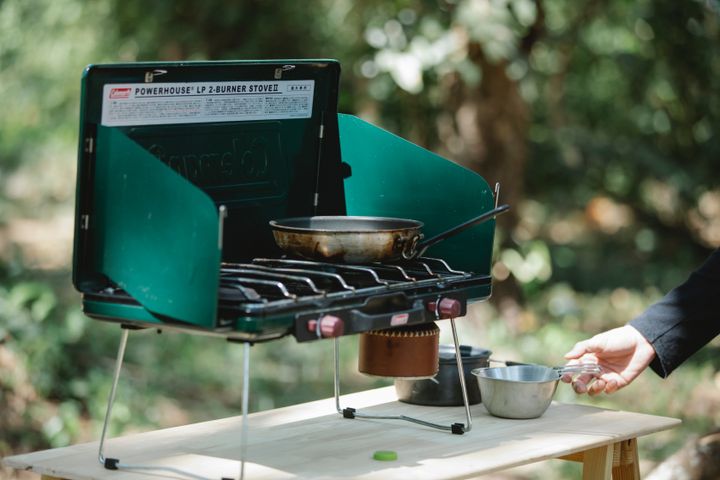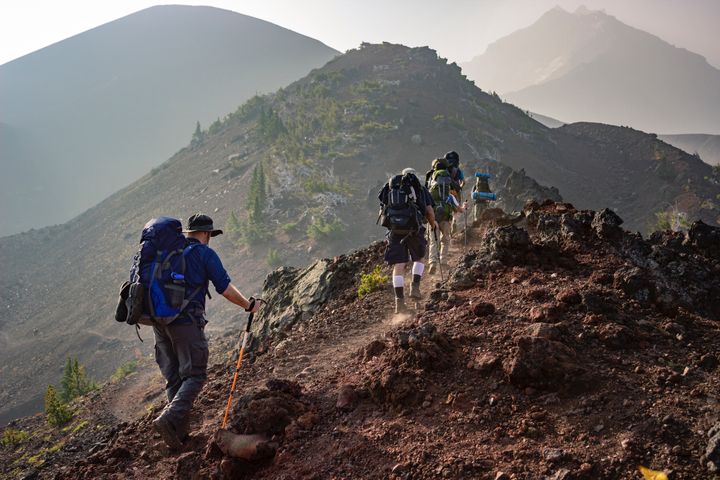Avoid a Bear Attack While Camping In Bear Country
Worried about bears? Don't let it stop you from having a great camping experience - get equipped with knowledge and tools to reduce your risk.

Are you a nature-lover who’s concerned about encountering bears while camping?
Don't let anything stop you from having the outdoor adventure of a lifetime! Equip yourself with the knowledge and tools to help reduce your risk in bear country. With our best tips and advice based on real-world experience and some tips from experts, you'll be able to prepare for every potential encounter and not attract bears.
So, spend less time worrying and more time exploring this summer with your family and friends. Knowing how to protect yourself in bear country and following these safety tips adds a layer of safety that helps you focus on the fun memory-making abilities of camping.
Come along with us on this journey as we walk straight through the middle of this potentially anxiety-inducing topic as we do a little bear country planning so we all stay safe.
Get your free downloadable camping checklist here!
Types of Bears

Black Bear: The black bear is the most common type of bear in the United States and can be found in 40 of the 50 states, primarily in densely wooded areas or mountainous regions. They are omnivorous, meaning they feed on a variety of foods, including fruits, nuts, insects, and even small animals. Wild black bears are not naturally predators of humans so black bear attacks are only common due to their population size proportionally.

Brown Bear: Brown bears are native to Northern North America from Alaska to Mexico and can be found as far east as Newfoundland and Labrador. Brown bears have a large diet composed mainly of vegetation such as roots, grasses and berries but also includes fish (salmon) and small mammals.

Polar Bear: Polar bears live mainly along the coastlines of the Arctic Ocean in parts of Canada, Alaska, Norway and Russia but have been known to appear occasionally along the US coastline near Alaska. They are carnivorous predators whose diet consists mostly of seals which they hunt on sheets of sea ice.

Grizzly Bear: Grizzly Bears inhabit much of western North America including parts of Alaska down into Montana and Wyoming where they continue to exist in smaller numbers due to dense vegetation loss. In addition to vegetation they eat fish, small mammals such as rodents or rabbits and carrion (dead animals). Meeting one of these in Grizzly country will leave an impression no doubt, so be prepared.
Signs of Bear
When camping in bear-inhabited areas, it's important to be aware of the signs that bears may be near so you can take extra precautions and remain safe. One indication of the presence of a bear is noticing claw marks on trees or stumps; if a bear is frequenting your campsite, they will often mark their territory with their claws.

Another key sign to look out for is footprints in the ground; this could indicate that a bear has recently passed through the area. Also, if you're camping where there are berries or other fruit-bearing plants, any evidence of broken branches or chewed fruit skins can be an indication that a bear has been eating nearby. After the eating part, bear scat (poop) is proof positive of bear friends relatively close at hand. You should also consider the possibility of bears if you smell anything dead or rotting. This could indicate that a bear has recently killed and dragged away an animal carcass.
Finally, any loud noises such as growling, snapping twigs, and shuffling leaves should not be overlooked as these could suggest a nearby bear. By being aware of these warning signs when camping in bear-inhabited areas, you can help to protect yourself from harm and keep your campsite safe.
Bear Attacks
Bears are large and powerful animals, and they can be very dangerous when provoked or surprised. In the United States, bears are present in all wilderness areas, leading to potential attacks on unsuspecting campers in these regions. The most common bear species found in the United States are the American black bear and grizzly bear, both of which pose a threat to those who come across them unexpectedly. Keep in mind, most bears do try to stay away from humans if at all possible. Removing that possibility creates anxiety in the bears.
Most attacks occur when a bear is startled or feels threatened by a person’s presence. Campers should take extra caution to avoid surprising nearby bears since encounters like this increase the risk of an attack. Bear attacks are quite rare but they do happen; therefore, it’s important to stay alert while camping in areas inhabited by bears, practice bear safety measures such as storing food properly, and making noise while hiking. Even carry bear spray for self-defense if absolutely necessary.
Aggressive Bear

Bears are typically shy and non-aggressive animals, but when feeling threatened and the bear decides it is in danger, they may become aggressive in order to protect themselves. Factors such as proximity to the bear's den or food source, surprise encounters, and the presence of cubs can all make bears more prone to expressing aggression. It is important to be aware of these situations and take extra precautions when necessary in order to avoid an unsafe encounter with a bear. Additionally, it is always best to follow recommended protocols for bear safety while camping or visiting national parks. Keep in mind all this includes young bears as well.
Storing Food & Trash
When camping in an area with bears, it is important to take preventative measures to avoid a potential encounter. One of the best ways to do this is to properly store food and trash. We are not the only ones out there that crave human food.
Food Storage
For food, make sure that all items are sealed in airtight containers and stored away from your campsite, preferably at least 100 yards away if possible. This will not only keep the scent away from your site, but also give you a little more peace of mind when sleeping. If you can’t store food that far away, hang it up in a tree at least 10 feet off the ground and 4 feet away from the trunk. Make sure to use metal containers or metal bear proof sealed plastic bags as these will be more difficult to access for animals. Bears learn where we humans keep our food and have even been known to break into cars with food inside.
More on campsite safety here...

Trash Storage
For trash, make sure that it is all placed inside garbage bags or bear canisters and emptied out on a regular basis throughout your camping trip. Make sure all items are tightly sealed within the bag so that no scent can escape and attract animals. Additionally, place these bags in an area away from your campsite again; preferably at least 100 yards away if possible.
Bear Box

One of the best ways to do this is to store food and other scented items in a bear box. Bear boxes, or a bear canister, are designed to be at least partially bear proof and keep scents from spreading, preventing bears from smelling and approaching your campsite. Make sure to read up on local regulations for approved bear boxes or bear canisters and remember to never leave food or scented items unattended in your campsite.
By taking the necessary precautions such as properly storing food and trash when camping in an area with bears, it can help reduce the chances of a potentially dangerous encounter with wildlife. It is important to remember that bears have an incredible sense of smell, so making sure that anything smelly is kept far away from your campsite is essential for keeping everyone safe during their stay.
Bear Encounter When In Camp
If a bear enters your campsite while camping, it is important to remain calm and not panic. It is also important that you do not run away or make sudden movements, as this may cause the bear to become more agitated. Instead, stay still and back away slowly while making noise, such as talking in a low, steady voice or clapping your hands. Make sure you do this in a slow and smooth motion so that the bear knows you are there but does not feel threatened. You should also try to grab any food or garbage that is lying around to reduce the chance of attracting the bear back again later after it has left.
In some cases, bears may be scared off by yelling or other loud noises like if you bang pots together; however, this could potentially have the opposite effect and further agitate the animal. If necessary, use a deterrent such as an airhorn or bear bell to make enough noise that will encourage the bear to leave without causing undue harm or stress. If necessary, hiding under the picnic table may discourage a bear. If worse comes to worst and the animal does not retreat from your campsite after all of these techniques, contact local wildlife authorities for assistance. They are best equipped to handle dangerous wildlife encounters safely and effectively.
Bear Encounter On The Trail

If you encounter a bear while hiking on a trail, the first thing to do is to stay calm and remain in place. Do not make any sudden movements or loud noises that could startle the bear and cause it to become aggressive. It is important to remember that bears are wild animals and their behavior can be unpredictable.
Next, assess the situation. If the bear is at a distance, back away slowly while maintaining eye contact with the animal and speaking calmly. Do not turn your back on the bear as this may provoke it and make it more likely to attack.
Be sure to keep small children close by and avoid running away from the animal, as this may trigger its hunting instinct. If you have food or other scented items with you, try to secure them to avoid further aggravating the animal. If all else fails, look for an escape route off of the trail and seek shelter in a nearby tree trunk, building or car if available.
Finally, if the bear approaches closely or shows signs of aggression such as huffing, barking, swatting at objects, salivating excessively or popping its jaws open and closed, stand tall and spread your arms out wide while speaking firmly in low tones or growling– this will help convey that you are not prey but rather an intimidating figure who should be respected enough to keep its distance.
Bear Defense
When faced with a bear attack, one of the most effective defensive measures is to stay calm and use bear spray. Bear spray is an aerosol pepper spray containing capsaicin, oleoresin capsicum, and other irritant chemicals that causes severe eye and respiratory irritation. When sprayed at a bear, it will temporarily incapacitate the animal and make it retreat.
Trekking Poles
Trekking poles are a great tool to keep while camping in bear country. In the event of a close encounter with a black bear, you can use your trekking poles to create space and defend yourself. The poles provide an additional layer of protection and can help prevent any physical contact with the bear. Make sure to research the specific protocols for how to safely use your trekking poles when dealing with bears, as well as other tips for avoiding bear encounters.
Noise
Another effective defensive measure against bears is to create noise. Talking loudly or shouting is proven to be intimidating enough for bears to avoid human contact. Additionally, noisemakers such as bear bells, whistles or air horns can also be used to scare off any bears that might be nearby.
It’s also important to know how to act if you do encounter a bear: try not to make sudden movements and back away slowly while facing the bear at all times.
Bear Cubs

Never put yourself between a mother bear and her cubs; instead, stand tall, wave your arms up in the air, shout again in order to appear more intimidating by increasing your size; this often works well for smaller black bears.
Finally, people should always carry some form of protection when traveling outdoors in places where bears are known to inhabit; firearms are often seen as the most viable option but they should only be used as a last resort when dealing with aggressive animals as they can lead to fatal consequences both for the person using them or the animal itself. If you do not have any of those options available to you, the National Park Service recommends in the even of a brown or Grizzly bear attack to lay face down, legs spread, play dead and not let it turn you over until it leaves.
National Park Service
When visiting national parks, it is important to be bear aware and take the necessary precautions to ensure your safety. The National Park Service recommends that visitors store all food and scented items in approved bear-resistant containers, also known as bear boxes. Additionally, it is advised to keep a clean camp by immediately cleaning up any food or waste left behind from meals. It is also a good idea to never approach or feed bears, as well as stay alert while hiking and look out for signs of bear activity.
The National Forest Service also recommends reading the Be Bear Aware Campaign information to gain further understanding bear behavior. Anytime you are in sight of park rangers, know that they are more than willing to answer any questions you may have.
Final Thoughts
As we can see, camping has the benefit of creating long lasting memories and beautiful experiences. Although many campers worry about running into a bear, there are plenty of precautions you can take to minimize your chances of having a close encounter. Most importantly, whether it’s enjoying nature or trying something new, always remember that the most important part of the journey is the people around us, which makes our experiences all the better.
So, get a bear bell, some scent-free food bags and plan that trip knowing that you can significantly reduce the chance of a bear encounter. Whether on hiking trails, in camp, or in your sleeping area, all of this is designed to help you avoid bears.
All in all, I invite you to join me on my camping-adventure journey and explore the great outdoors with me. From pitching tents to building fire pits, with enough focus and luck, we can keep ourselves and Mother Nature safe while enjoying all the adventures the world has to offer. So are you ready? Consider subscribing so that when I post more about camping excursions and find out more ways to protect both people and paws on this earth. Until then, happy trails!
~Ron






Comments ()